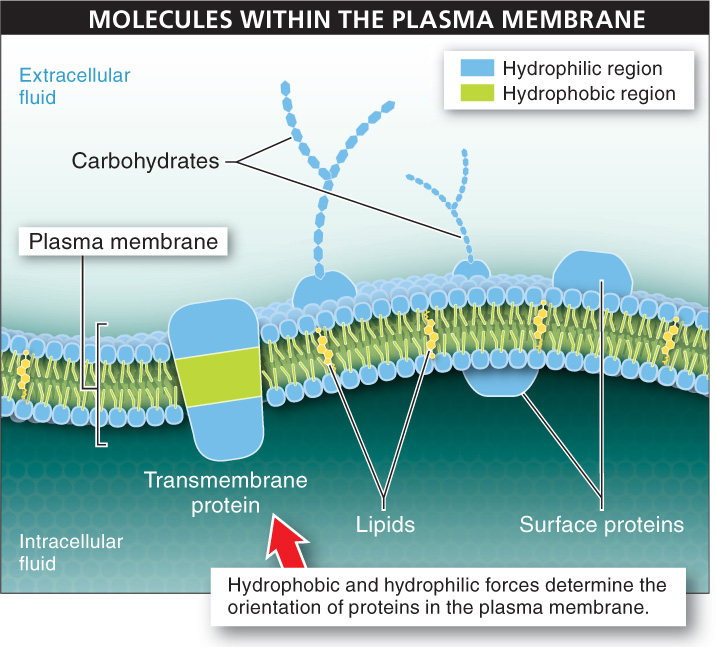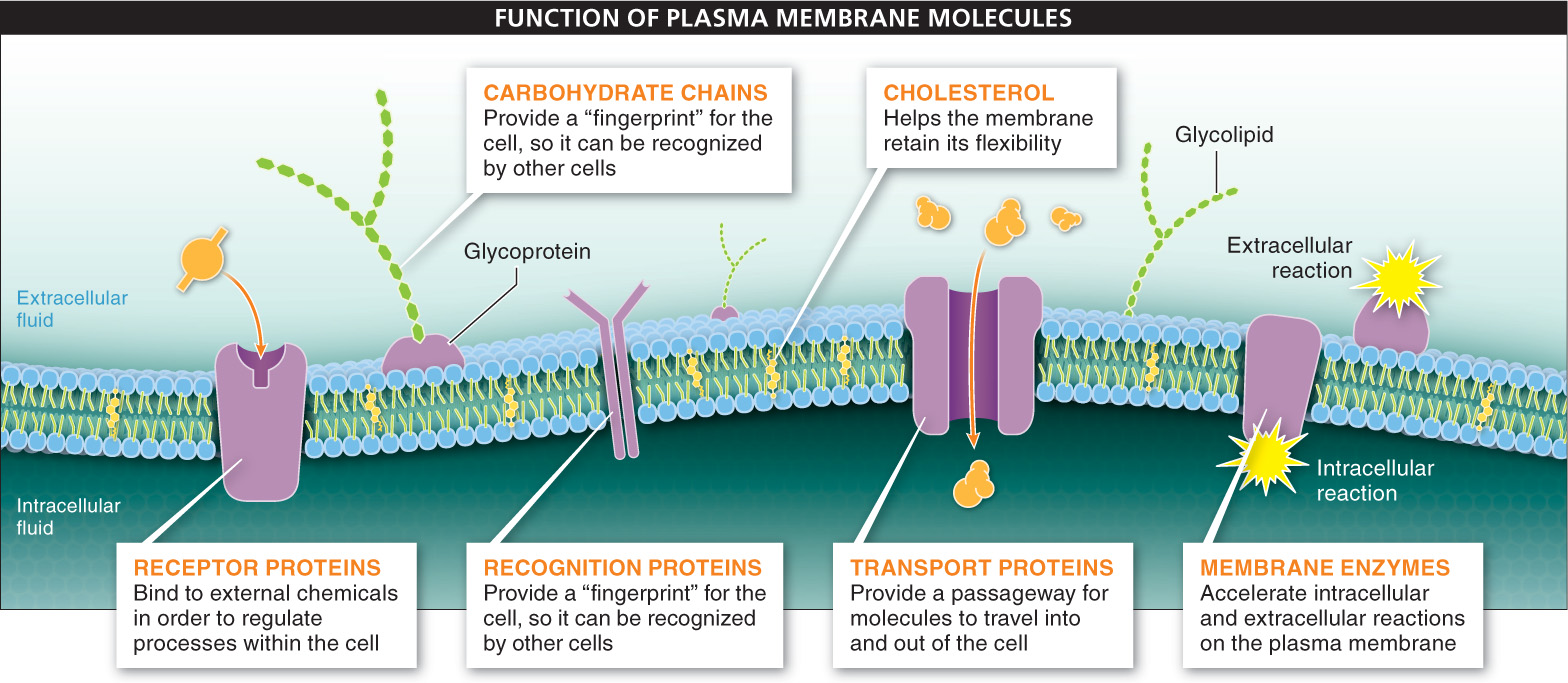The many different functions of the plasma membrane are accomplished with the help of different types of protein, carbohydrate, and lipid molecules embedded within or attached to the phospholipid bilayer. Many of these molecules float around, held in a proper orientation by hydrophobic and hydrophilic forces, but not always anchored in place. For these reasons, the plasma membrane is often described as a fluid mosaic (FIGURE 3-11).

For every 50–
What determines whether a protein resides on the surface or extends through the bilayer? Its tertiary structure. Remember from Chapter 2 that all the amino acids that make up each protein have side chains that differ from one another chemically. Some of these side chains are hydrophobic, others are hydrophilic, and as a protein is assembled into its final shape, these side chains can cause parts of the protein to be attracted to hydrophobic or hydrophilic regions of the molecule. Because a transmembrane protein has both hydrophobic and hydrophilic regions, part of the protein can be positioned in the hydrophobic region in the center of the membrane while the other parts are in the hydrophilic regions. Surface membrane proteins, on the other hand, have an entirely hydrophilic structure and reside on the membrane surface, bound only to the head regions of the phospholipids. As a consequence, they can be positioned on either the outer or the inner surface of the membrane.
Once membrane proteins are in place, the hydrophobic and hydrophilic forces keep them properly oriented. Because all of the components of the plasma membrane are held in the membrane in this manner, they can float around without ever popping out.
There are several primary types of membrane proteins, each of which performs a different function (FIGURE 3-12).

97
- 1. Receptor proteins are surface or transmembrane proteins that bind to chemicals in the cell’s external environment. In doing so, receptor proteins can attach a cell to the extracellular matrix or convey information from the outside to the inside of the cell, regulating certain processes within the cell. This receptor-
mediated regulation is a process called signal transduction.
Cells in the heart, for example, have receptor proteins that bind to adrenaline, a chemical released into the bloodstream in times of extreme stress or fright. When adrenaline binds to these heart cells, the cells increase the heart’s rate of contraction to pump blood through the body more quickly. You have experienced this reaction if you’ve ever been startled and felt your heart start to pound. - 2. Recognition proteins are surface or transmembrane proteins that give each cell a “fingerprint” that makes it possible for the body’s immune system (which fights off infections) to distinguish the cells that belong inside your body from those that are invaders and need to be attacked. Carbohydrates also play a role in recognition. Short glycoproteins on the outside of the cell membrane serve as part of the membrane’s fingerprint. Like receptor proteins, recognition proteins can also help cells bind to or adhere to other cells or molecules within the extracellular matrix.
- 3. Transport proteins are transmembrane proteins that help polar or charged substances pass through the plasma membrane. Transport proteins come in a variety of shapes and sizes, making it possible for a wide variety of molecules to be transported.
- 4. Membrane enzymes are surface or transmembrane proteins that accelerate chemical reactions on the plasma membrane’s surface. (A variety of membrane-
bound enzymatic proteins exist, with some accelerating reactions on the inside of the plasma membrane and others accelerating reactions on the outside of the plasma membrane.)
In addition to the various kinds of membrane proteins and the carbohydrate chains of membrane-
TAKE-HOME MESSAGE 3.5
The plasma membrane is a fluid mosaic of proteins, lipids, and carbohydrates. Proteins found in the plasma membrane enable it to carry out most of its gatekeeping functions. The proteins act as receptors, help molecules enter and leave the cell, and catalyze reactions on the inner and outer cell surfaces. In conjunction with carbohydrates, some plasma membrane proteins identify the cell to other cells. And, in addition to the phospholipids that make up most of the plasma membrane, cholesterol is an important lipid in some membranes, influencing fluidity.
List the four primary types of membrane proteins and their function.
The four primary types of membrane proteins are receptor proteins, recognition proteins, transport proteins, and membrane enzymes. Receptor proteins regulate certain processes within the cell by binding to chemicals in the cell’s external environment. Recognition proteins give each cell a “fingerprint” to identify the cell. Transport proteins help large or strongly charged molecules pass through the membrane. Membrane enzymes accelerate chemical reactions on the plasma membrane’s surface.
98